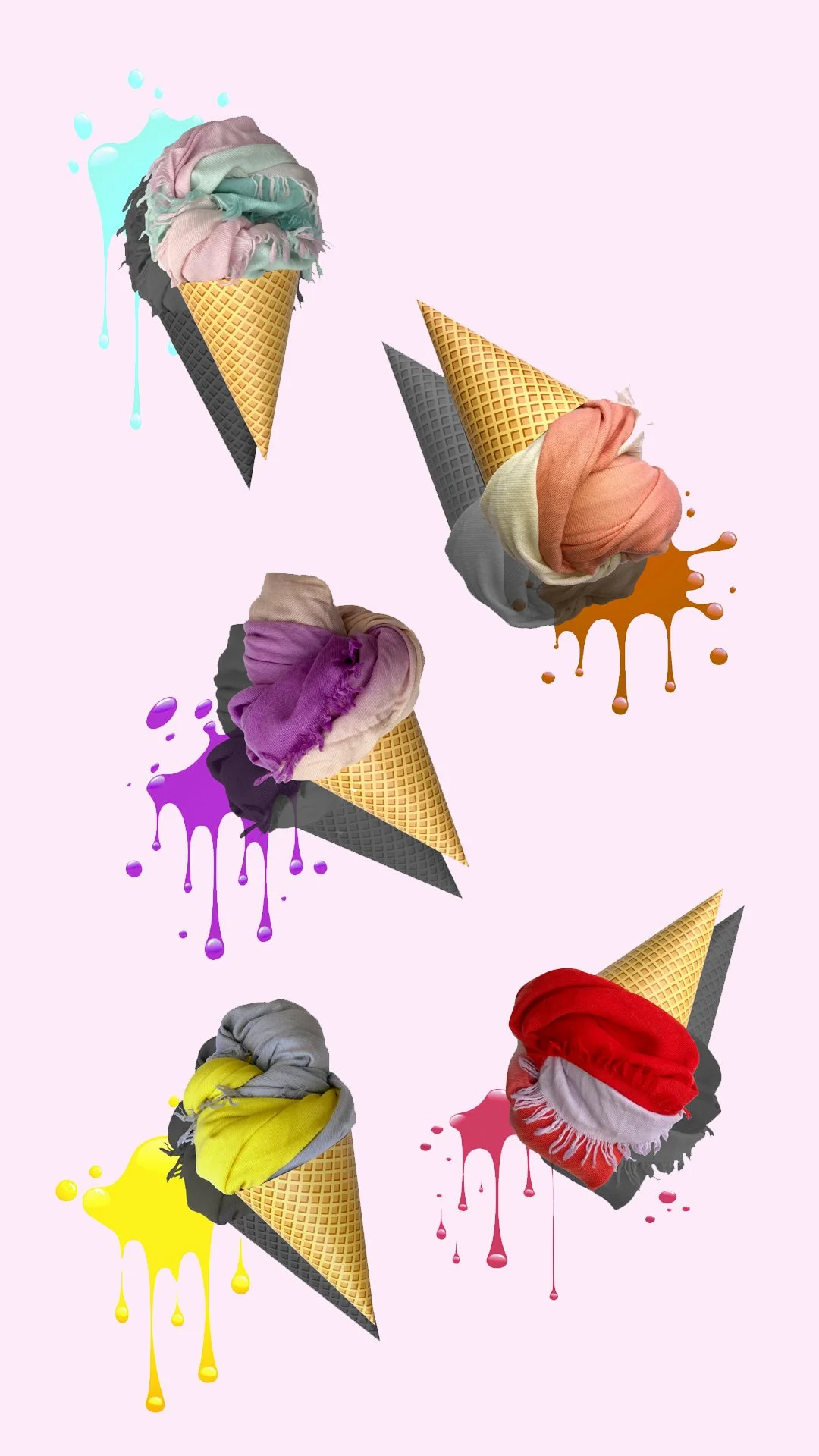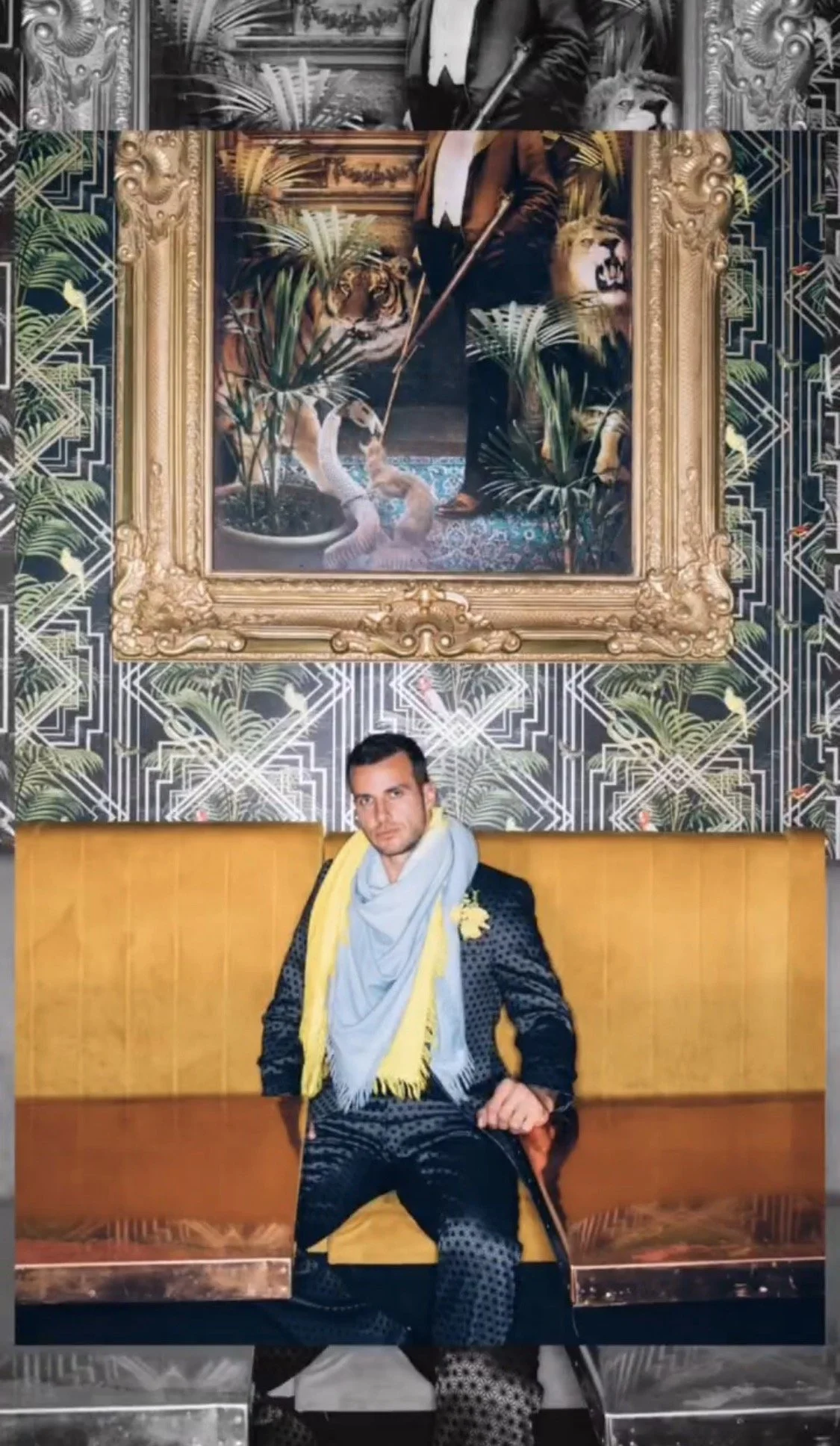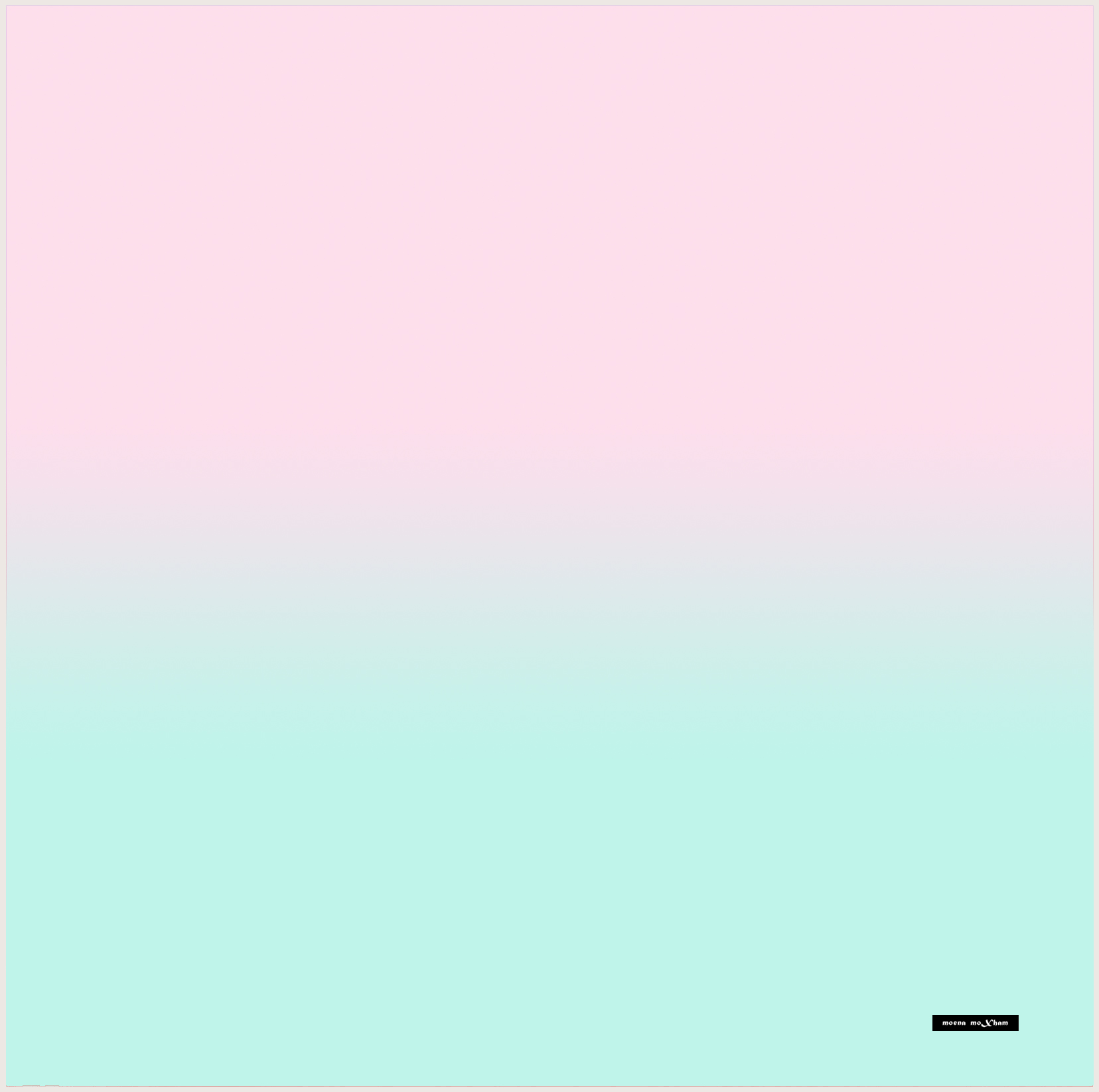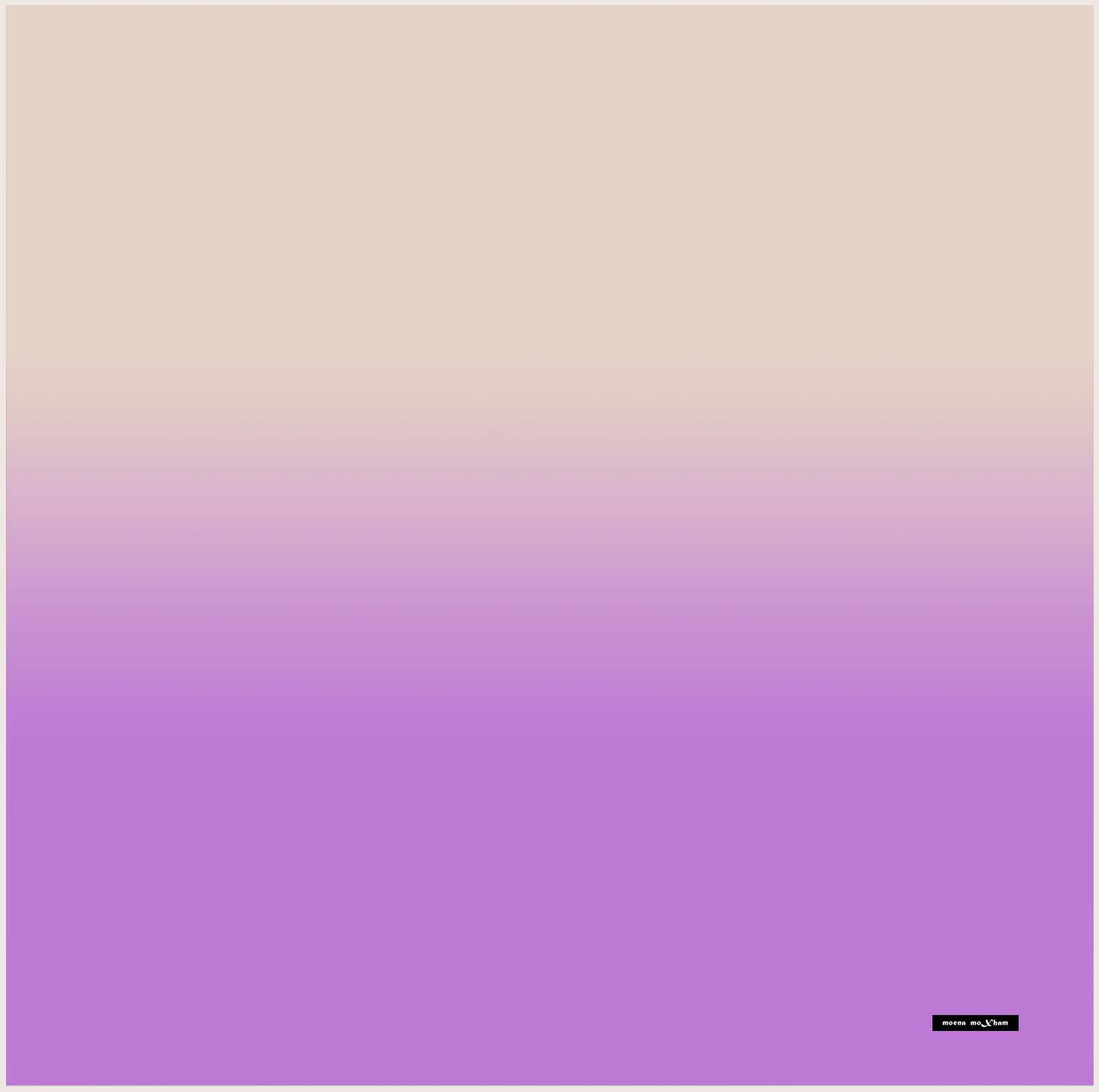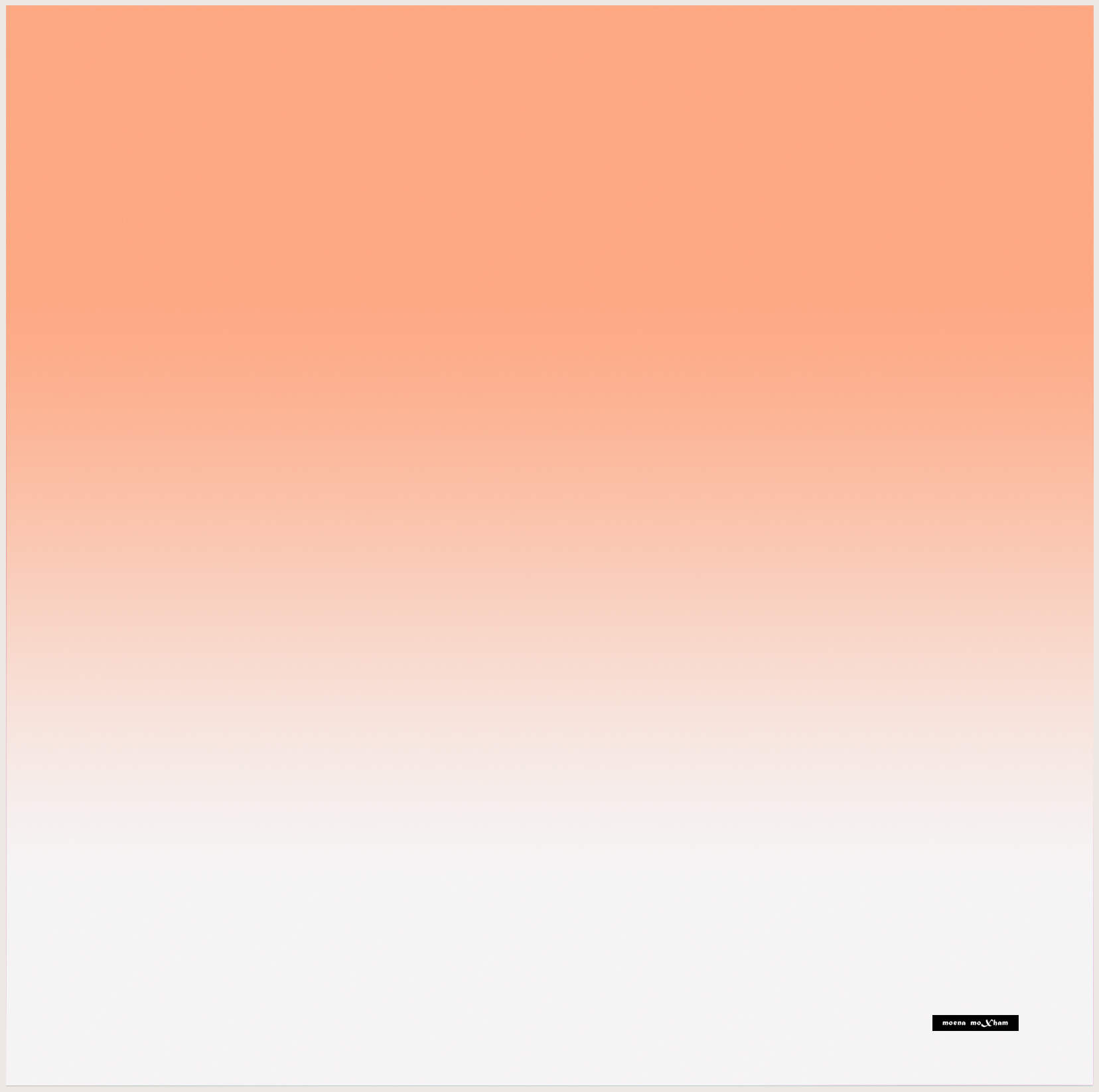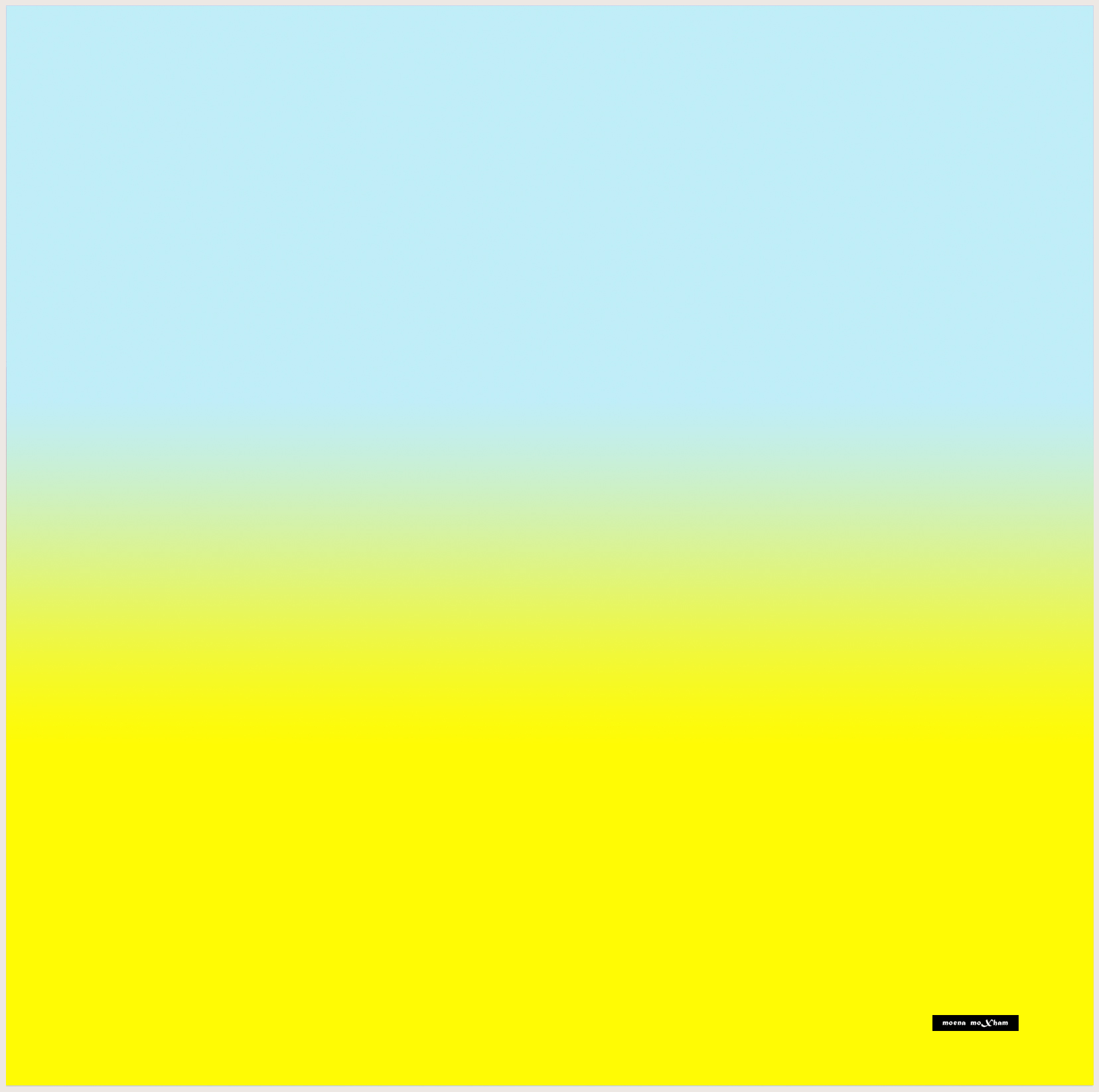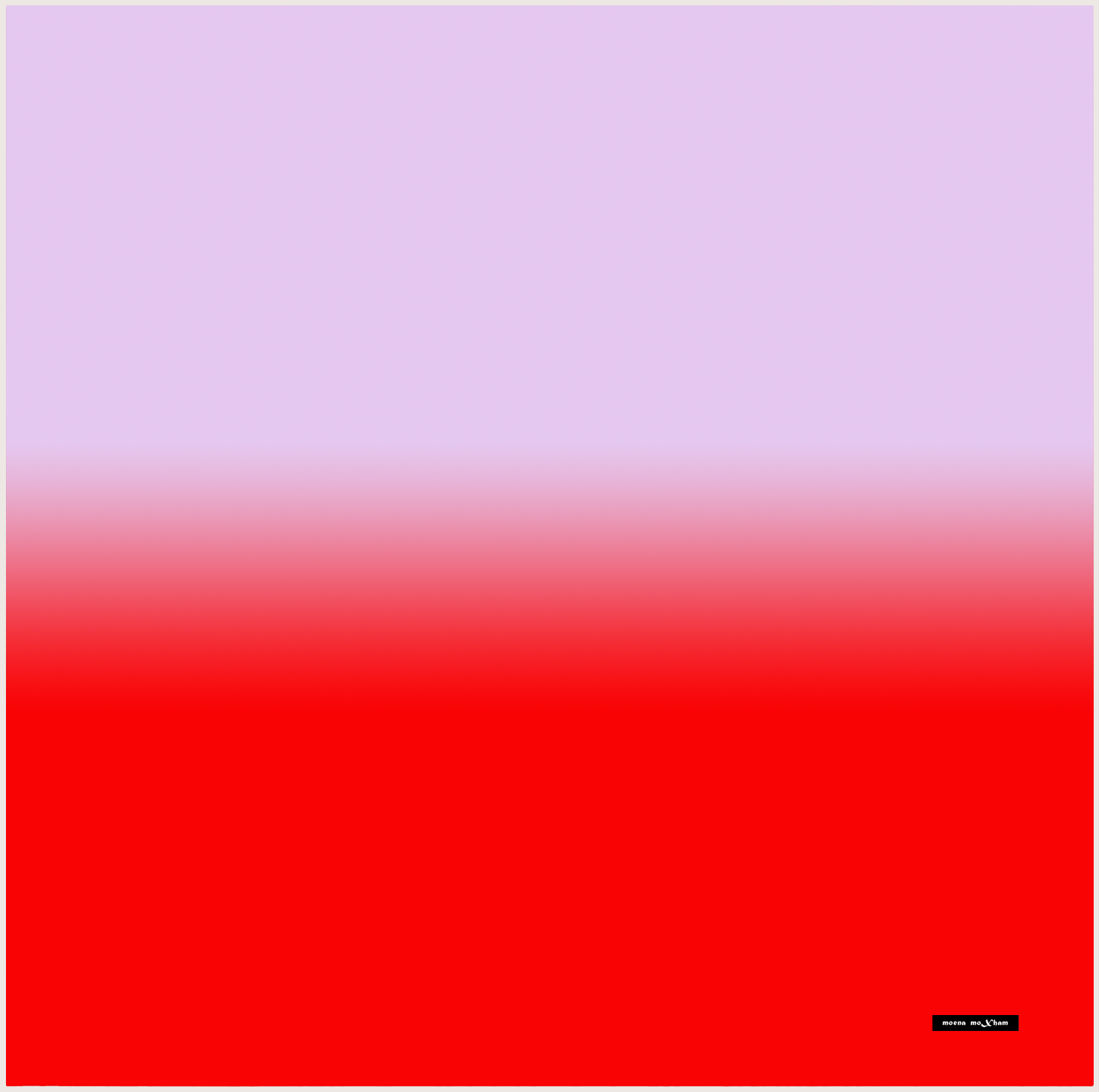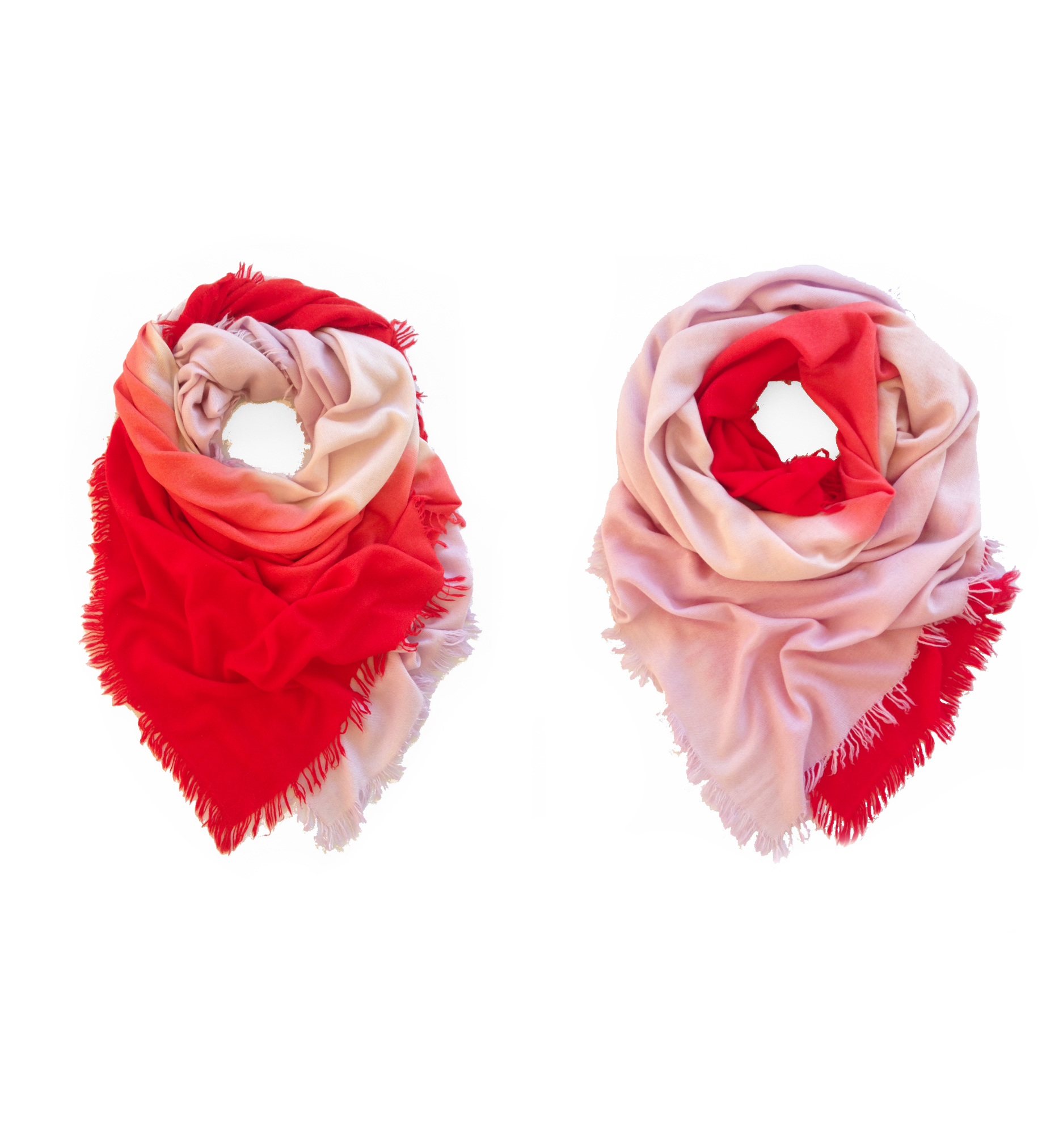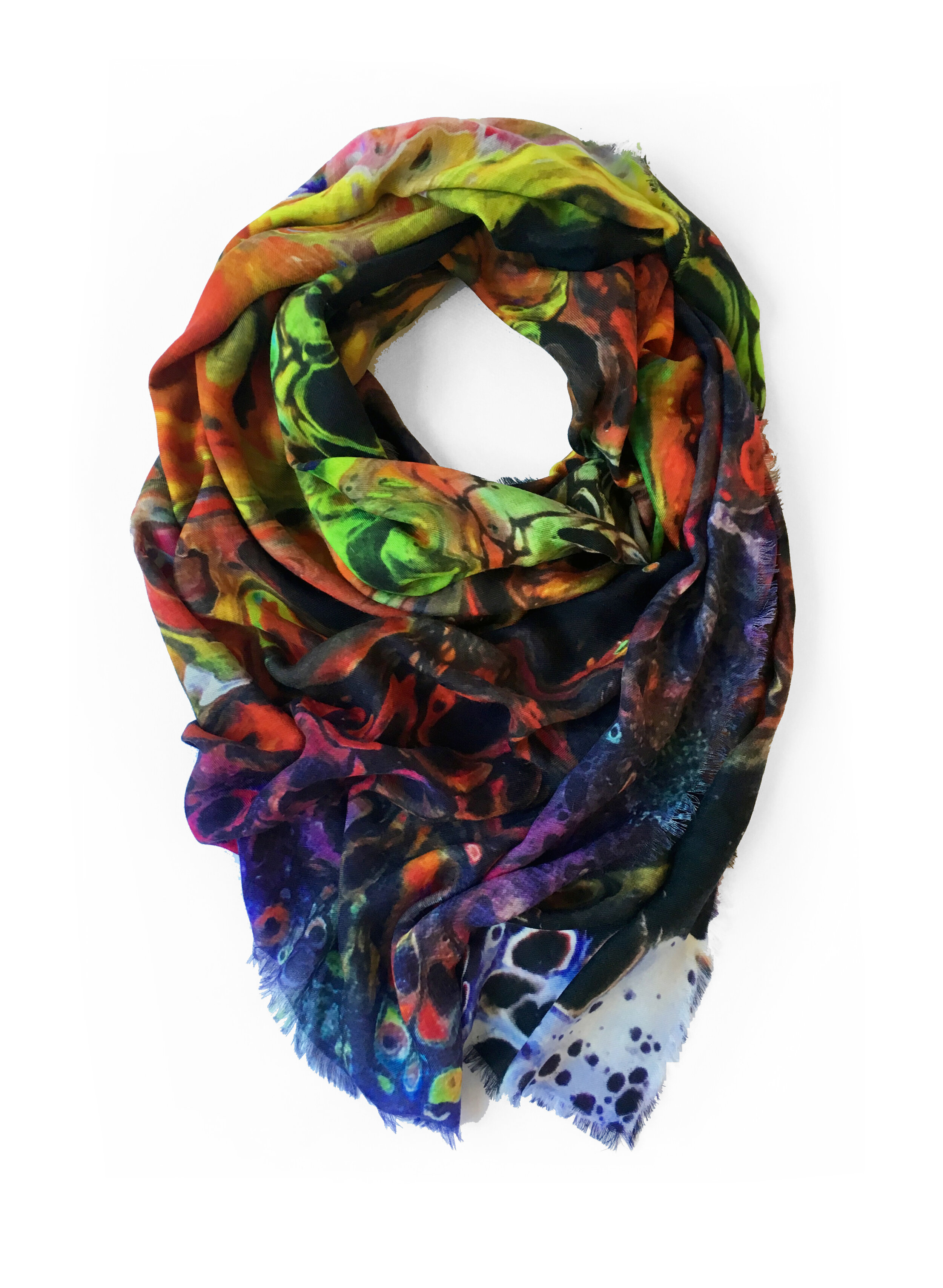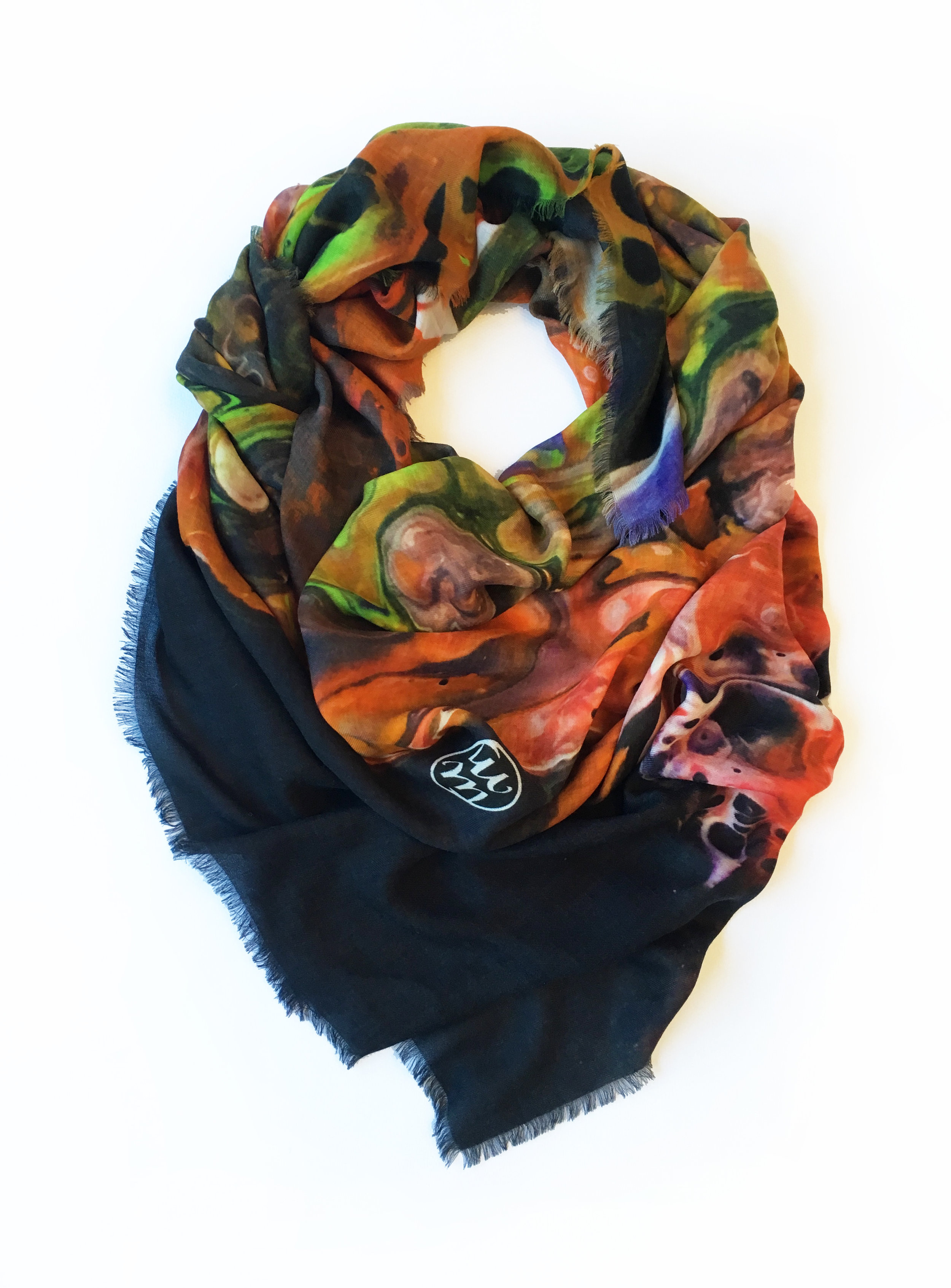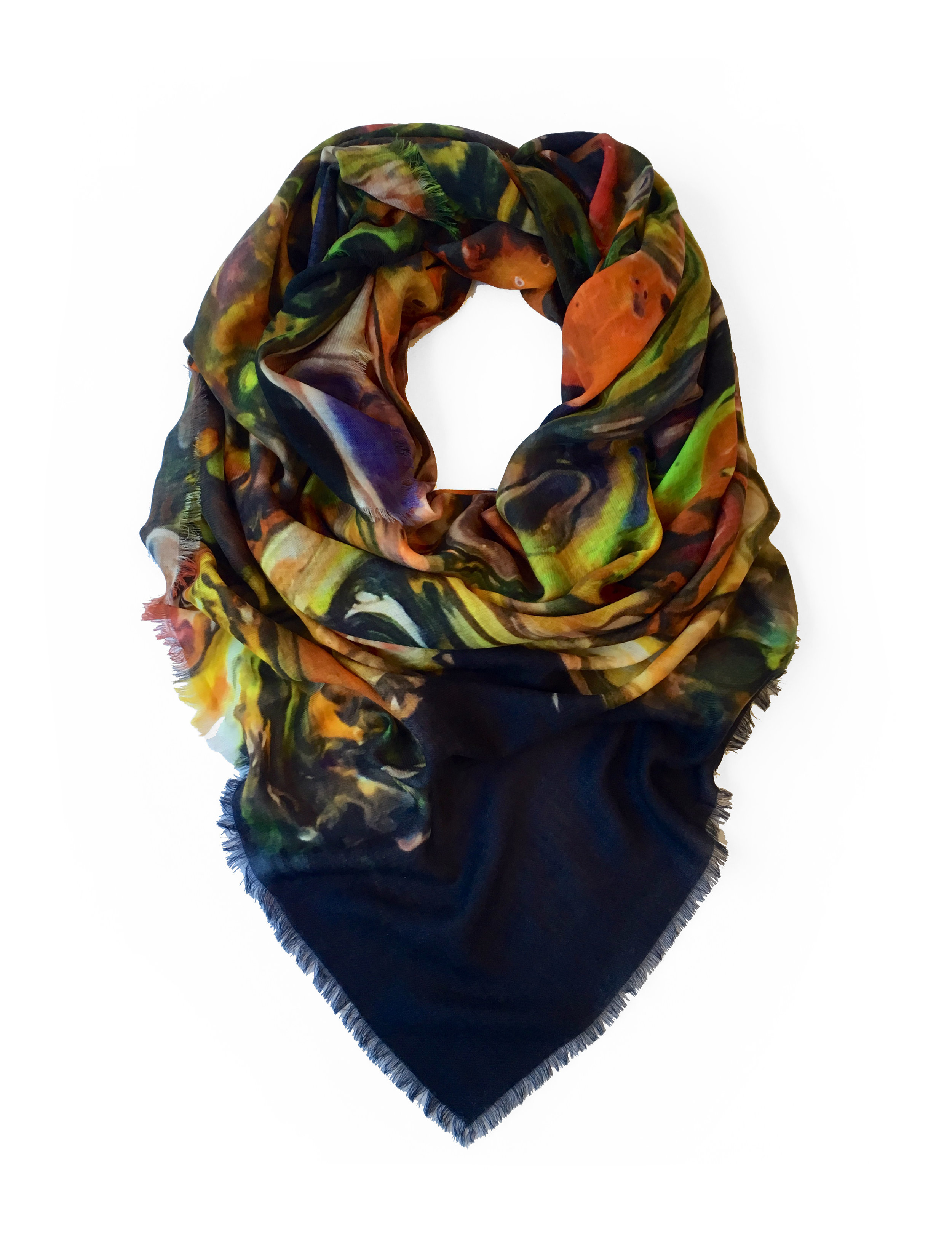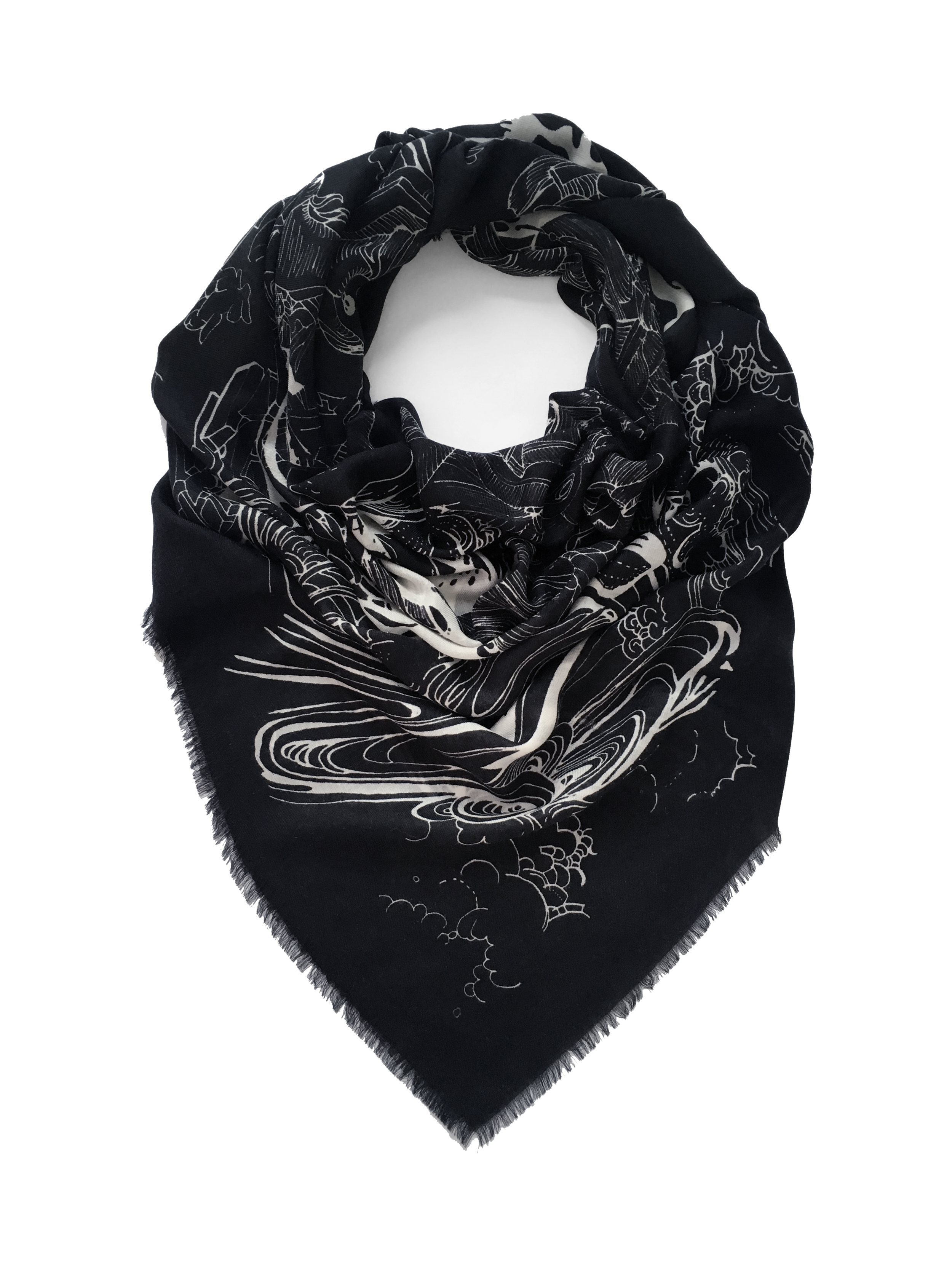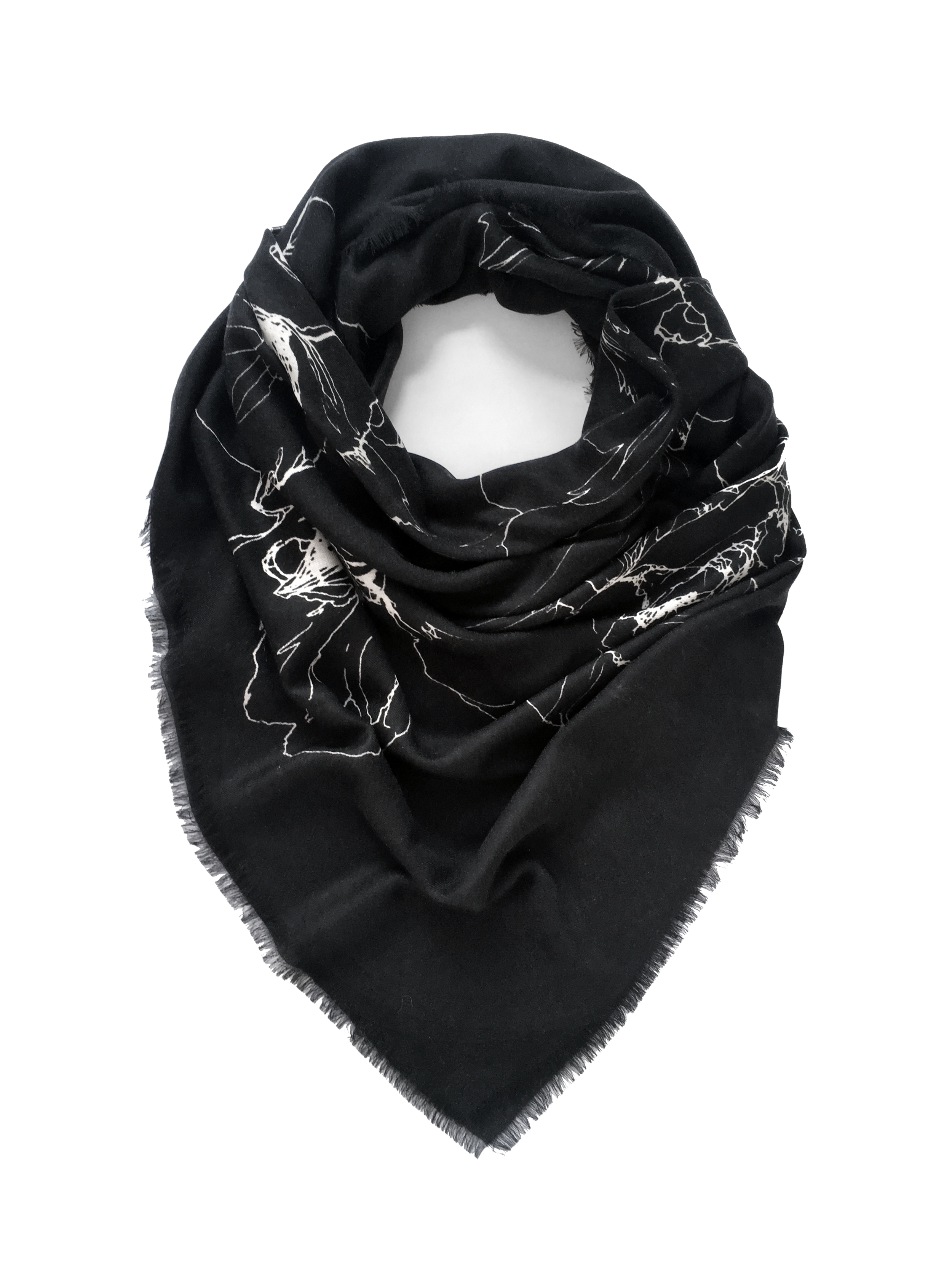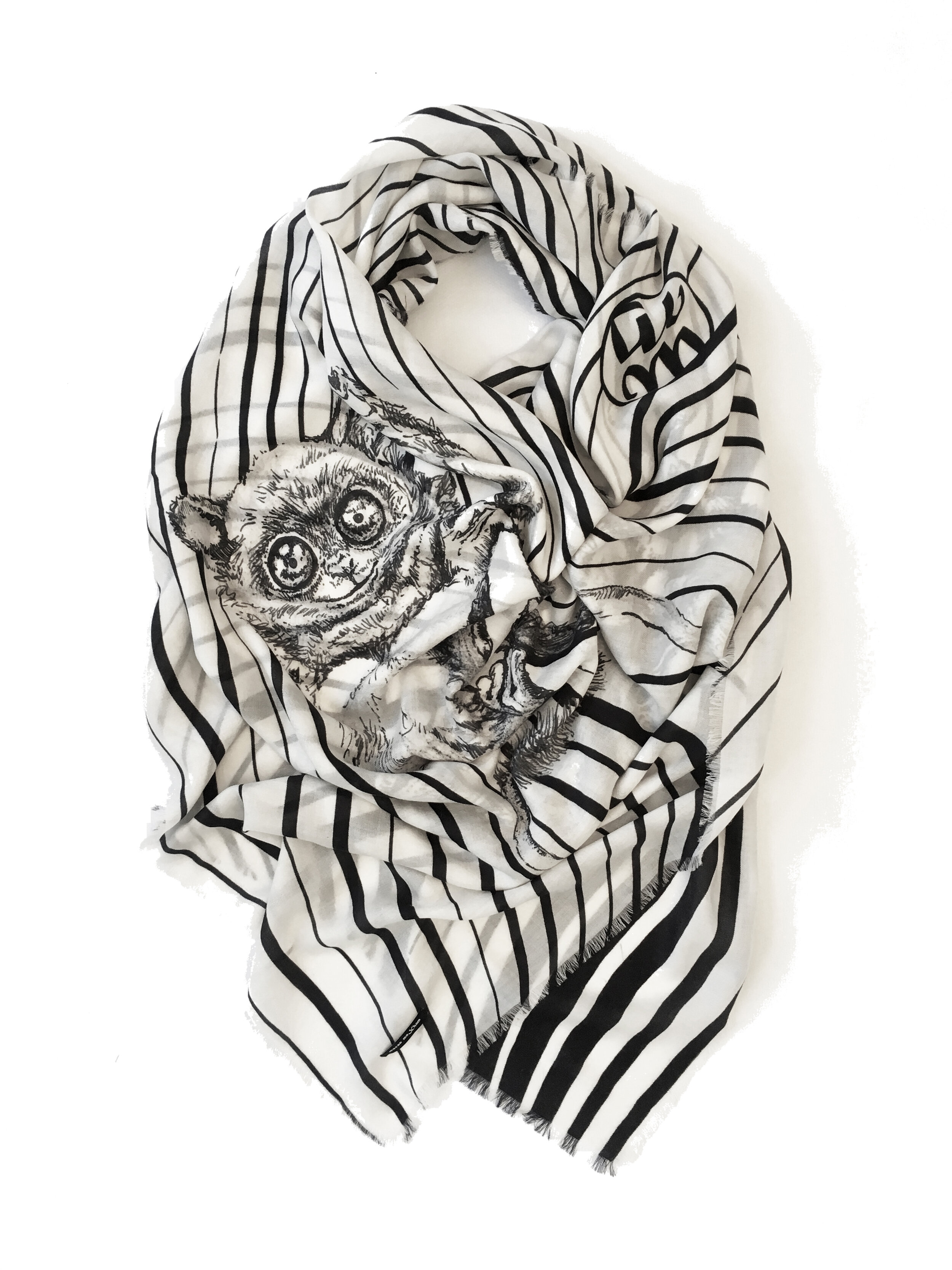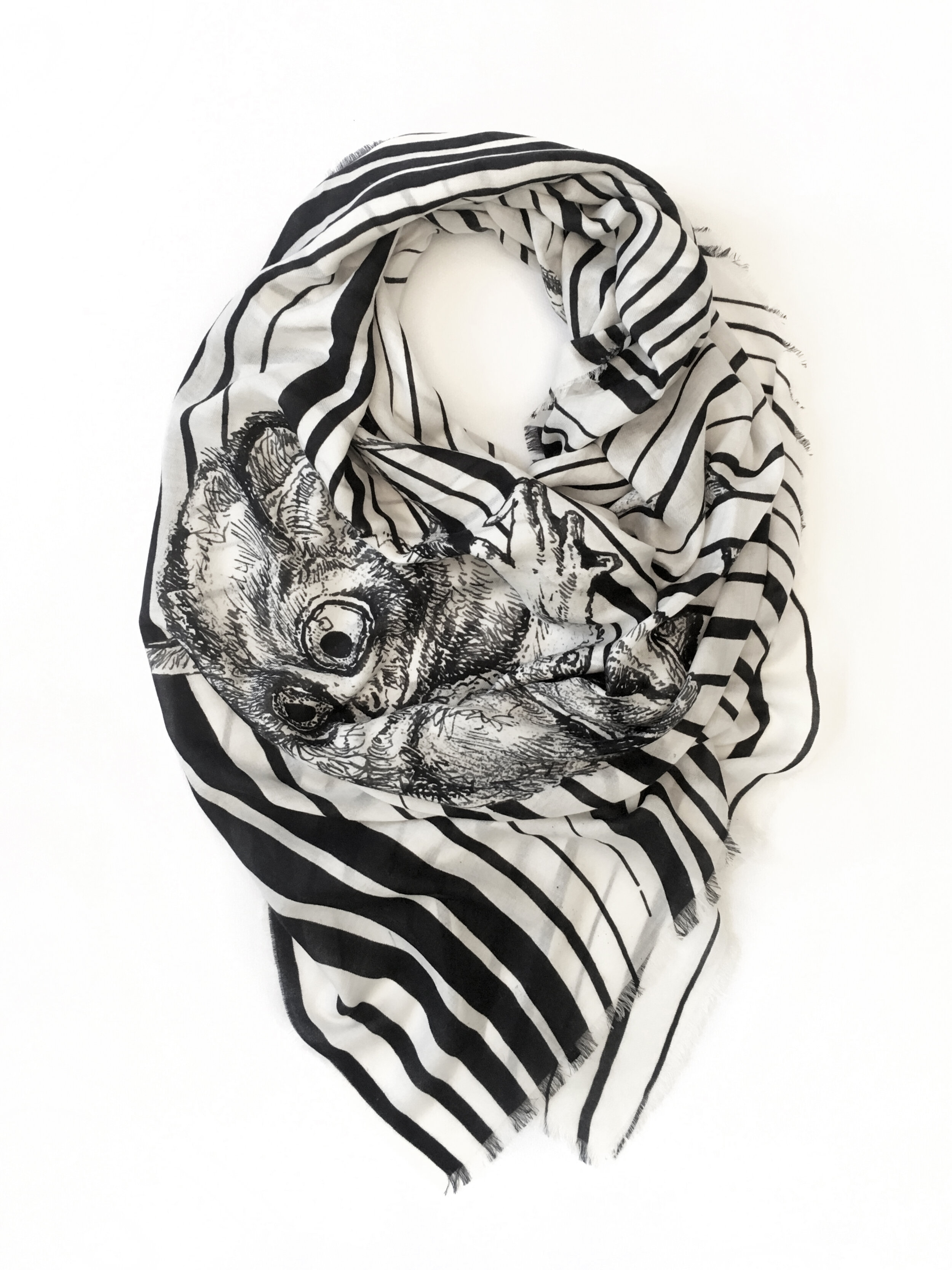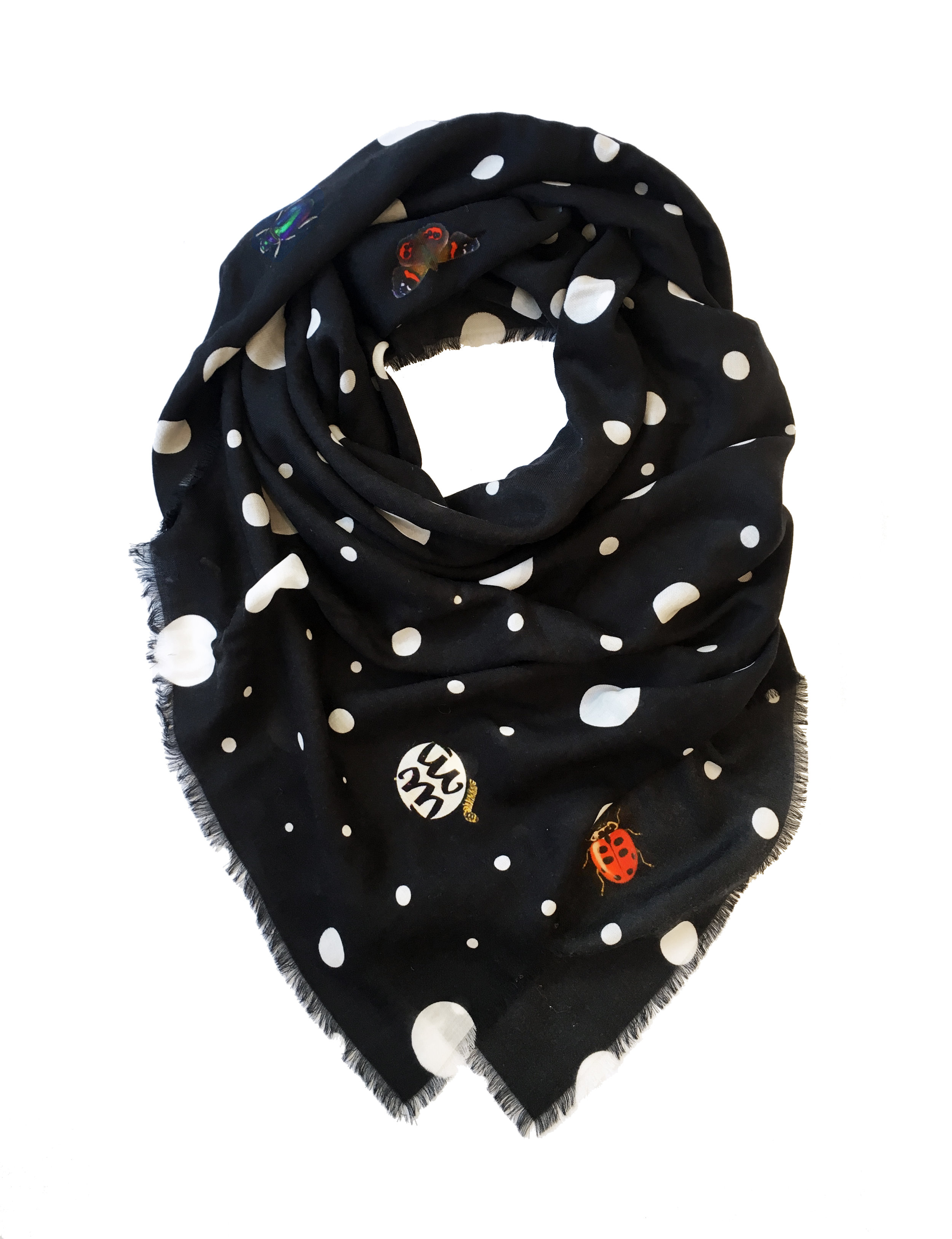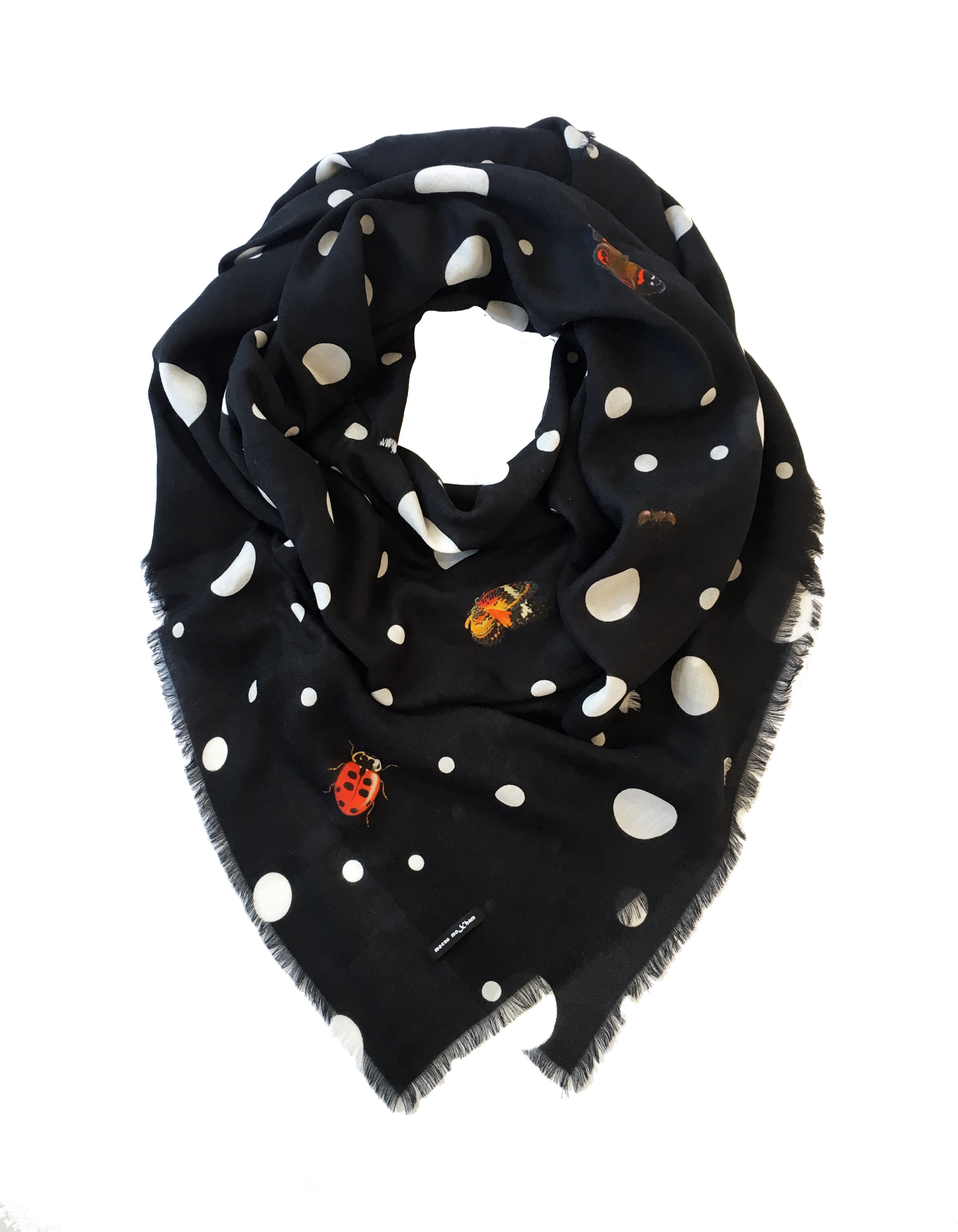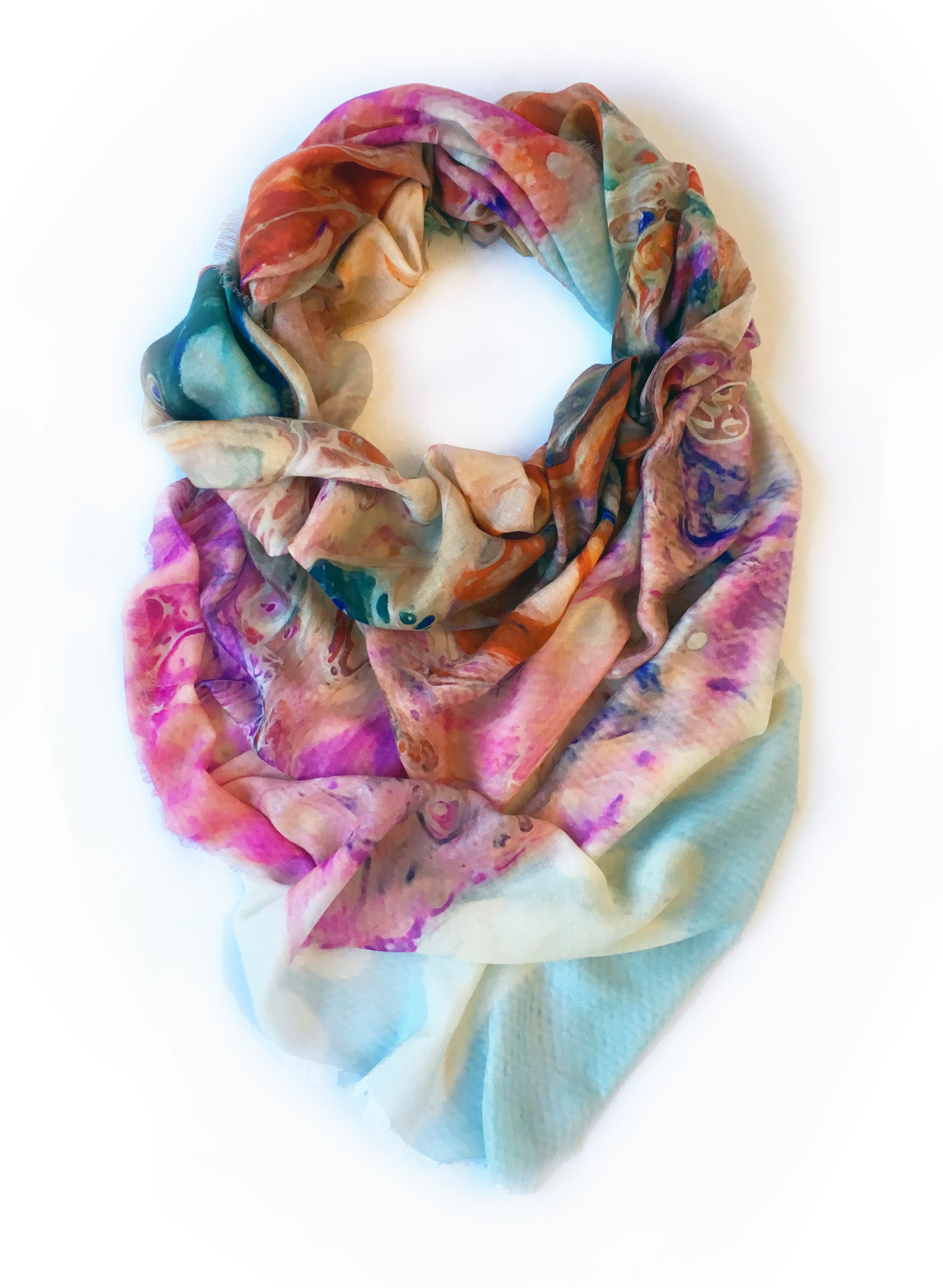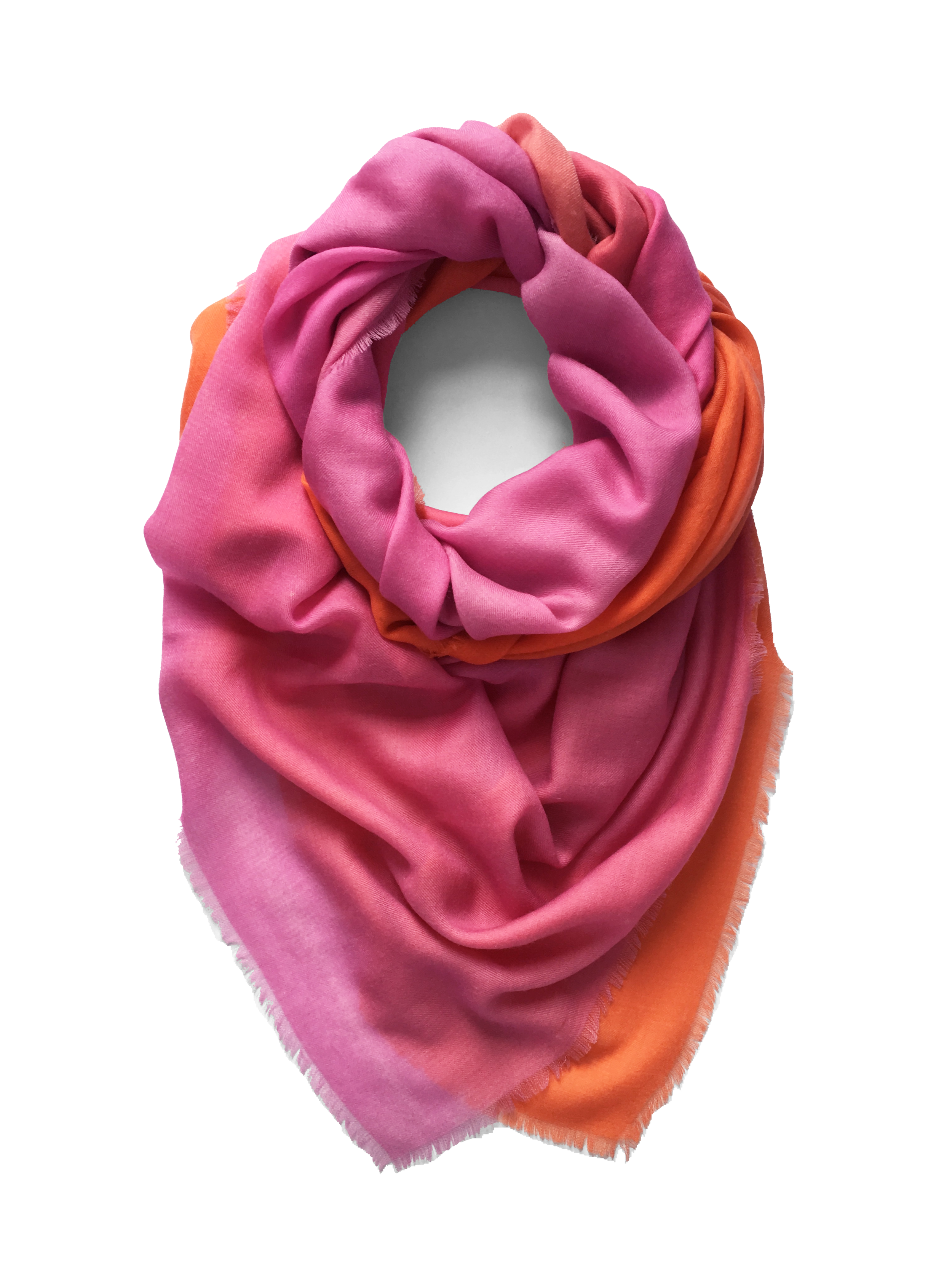CASHMERE SCARVES
Art and luxury have gone hand in hand together forever. Just like champagne and strawberries, some things are just meant to be paired. So there was no question when Moena Moxham decided to marry two of her favourite things; drawing and scarves that she would choose to immortalise these on cashmere.
Upon her travels through India, Kashmir, and Asia in 2017, Moena was enraptured with the qualities and weaves of cashmere she found, the traditional and modern textile application techniques that she saw being used, and the vibrancy of the yarns and dyes. Meeting and working with local suppliers and mills in New Delhi, Gulmarg & Srinagar (Kashmir)- (particularly Ip Singh and his family; one of the oldest merchants of cashmere and silk in Chandni Chowk), coincided with her developing new artworks for her own collection.
Moxham has an Honours Degree in Textile Design and is particularly interested in penetrative dye techniques. This means her scarves are both the same on the front as the back- a technical feat when printing onto natural woven fibres. Her eye for detail is not just focused on design- educated with first hand experience and knowledge about cashmere yarn, both in New Zealand and abroad, Moxham sources the finest cashmere available at the best price possible for the consumer. Please scroll to the bottom of the page to learn more about the wonderful qualities of cashmere.
Creating these stunning luxury items has taken her around the world but more importantly brought her into the lives of other dedicated and talented artisans and manufacturers who she now proudly calls friends. Moxham’s collections incorporate values of sustainability, ethical production, traceability, longevity, and quality manufacturing that will stand the test of time. Cashmere gets better with age, wash and wear. Selecting to purchase a cashmere item battles excess consumerism. If looked after well, a cashmere garment will be an item which one can enjoy for 10+ years, if not much longer.
Cashmere is a wonder fibre, it is eight times warmer than wool but much lighter; stores without wrinkles and modulates its insulating capacity based on humidity- so you are never too warm but always warm enough. Quality cashmere gets softer and better the more it is worn and washed, and is a sustainable source of fibre as the goats are combed or shorn for their wool.
Cashmere is trans-seasonal and because of this Moxham will release scarves as she designs them.
Moxham believes in creating articles that endure and are timeless. ‘Moena Moxham’ scarves are uni-sex, transgenerational and very versatile. They can be worn as a dress, trussed or tied with a belt as a top, shrugged on as a shawl or simply used as a blanket on long-haul flights or overnight excursions. A statement on their own or to bring colour and pattern to a simple outfit, scarves have always been an essential item for the minimalist traveller and fashionista. Below are diagrams of the many ways these gorgeous articles can be worn and appreciated with photos as reference.
Moxham has designed and created bespoke, eco-conscious packaging which presents each scarf in all it’s glory. Not only are these a beautiful way to store your beloved item, but they can also be repurposed as a place for keepsakes, treasures, mementos or stationary.
Each design is limited edition - keep coming back to see the latest release.
/// Please note- due to the nature of woven and printed fibres, the dimensions of the scarves can vary very fractionally from the designated size by +/- 2% \\\
Moena Moxham cashmere scarves are available for snuggling, fondling and enveloping… and then purchasing! from Flying Solo in Soho, NYC.
Photography: Bern Stock
Hair: Josh Brown | CHOP Hairdressing
Male Models: James Butters | The Butters Podcast
DELUXE WEIGHT
When Moxham wanted to create an artisanal, traceable and sustainable cashmere scarf collection, she reached out to a boutique company in Nepal she had been connected with through her travels. These exceptional craftsmen and women handloom and produce yardage at the factory. Material is hand-dyed, hand-finished and yardage is made onsite with the yarn traceable to Nepal, Tibet, China and Inner Mongolia. Their work for this collection was exceptional and it was a honor to collaborate with them to produce a collection with ethics and traceability.
↑ VIDEO’s - PRESS PLAY
Steven Taylor is featured wearing the luxurious deluxe weight ombré scarves. Steven is Manager & Coach of the Gulf United Football Club in Dubai. He is former Captain of the Wellington Phoenix Football Club and player for Newcastle United.
‘DUSK’
$600 USD
‘DAYSPRING’
$600 USD
160cm² (63”²), 100% Cashmere | Pashmina (read below for information on how only the finest cashmere can be classified as Pashmina), Deluxe heavy weight twill weave, Individually hand-dyed, Hand-loomed, Custom fringe detail (38mm/1.5”), Hand finished labelling, Reversible design, Five ombré colourways.
Handmade in Nepal.
Photoshoot Photography: David James
Photoshoot Fashion Provided by Mandatory Menswear, Zambesi & Sopheak Seng
Fashion Video Photoshoot: Moena Moxham @ Zambesi
Male Model: Steven Taylor
Special Mention of Thanks: Sopheak Seng, Michael Beel
MID-WEIGHT GRAPHIC AND COLOURED
↑ VIDEO’s - PRESS PLAY
‘PSYCHEDELIC ORCHID’
140cm² (55”²), 100% Cashmere, Eyelash fringe, Hand finished labelling, Reversible design
$600 USD
‘HAPPENING’
140cm² (55”²), 100% Cashmere, Eyelash fringe, Hand finished labelling, Reversible design
$600 USD

‘FIRMAMENT’
140cm² (55”²), 100% Cashmere, Eyelash fringe, Hand finished labelling, Reversible design
$600 USD
‘ETHER’
140cm² (55”²), 100% Cashmere, Eyelash fringe, Hand finished labelling, Reversible design
$600 USD

‘METAMORPHOSIS’
140cm² (55”²), 100% Cashmere, Eyelash fringe, Hand finished labelling, Reversible design
$600 USD

‘TRANSFIGURATION’
140cm² (55”²), 100% Cashmere, Eyelash fringe, Hand finished labelling, Reversible design
$600 USD

‘IRIS’
140cm² (55”²), 100% Cashmere, Eyelash fringe, Hand finished labelling, Reversible design
$600 USD

‘TARSIER’
140cm² (55”²), 100% Cashmere, Eyelash fringe, Hand finished labelling, Reversible design
$600 USD

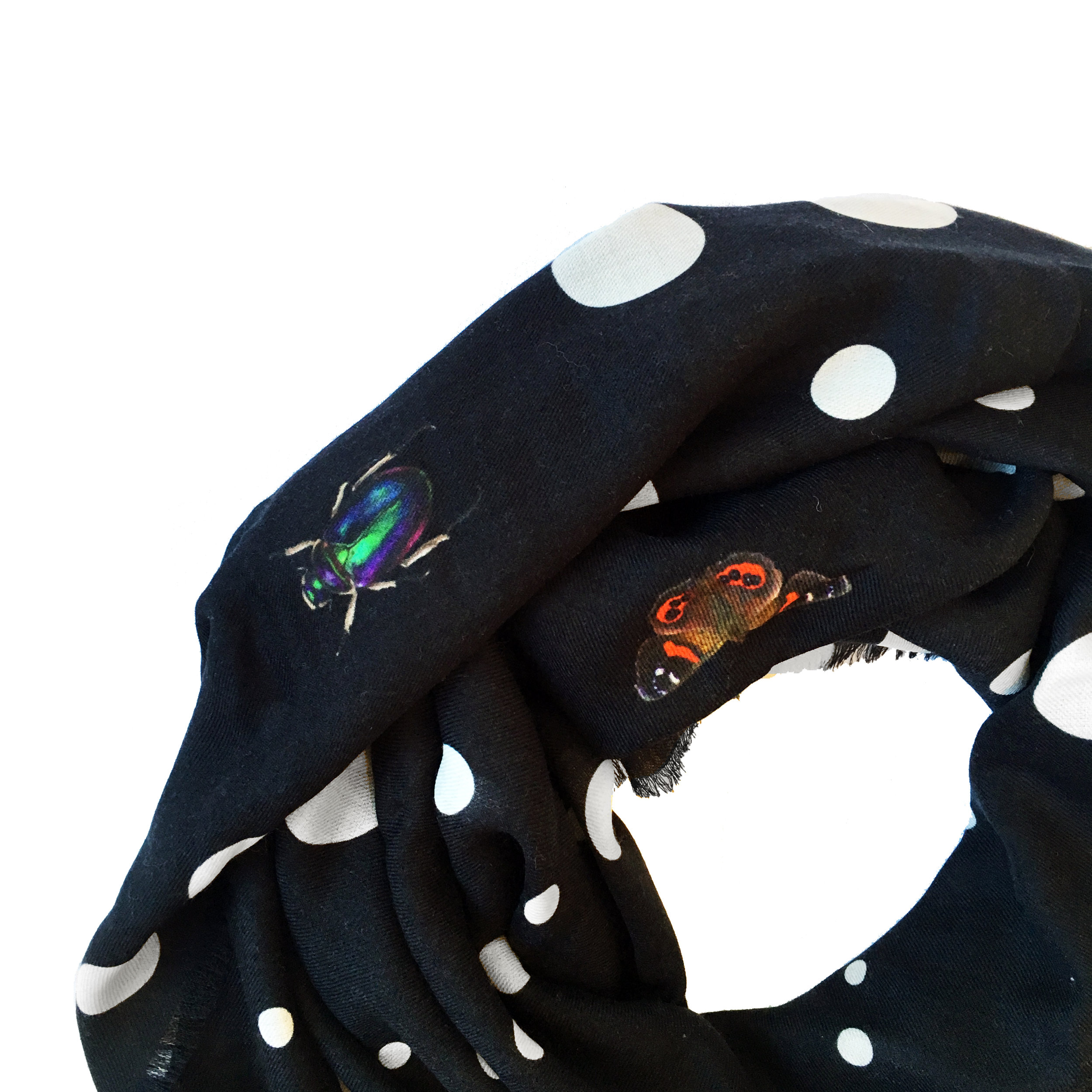
‘YAYOI INVERTED’
140cm² (55”²), 100% Cashmere, Eyelash fringe, Hand finished labelling, Reversible design
$600 USD

‘BIODIVERSITY’
140cm² (55”²), 100% Cashmere, Eyelash fringe, Hand finished labelling, Reversible design
$600 USD
‘EVENTIDE’
‘YAYOI’
The above designs are all 140cm² (55”²), 100% Cashmere, Eyelash fringe, Hand finished labelling, Reversible design
ABOUT CASHMERE & PASHMINA
Identifying the difference between Cashmere and Pashmina can be difficult as the wool of both has the same origin: the cashmere goat. Both, cashmere and pashmina, are exceptionally luxurious yarns and textiles. However, although cashmere and pashmina both refer to the same sort of product, there are subtle and unique characteristics that set them apart.
WHAT IS CASHMERE?
Cashmere is a term used to refer to the fibre obtained from the cashmere goat or clothing that is made from this. The texture of the cashmere is luxuriantly soft, strong, very fine and light and in turn gives very good insulation.
Raw (left) and de-haired (right) Cashmere Pashmina wool
Cashmere yarn is made from the soft fleecy under layer of a goat’s coat with the finest wool often found on the underside of the neck. These goats produce a double fleece that consists of a fine, soft undercoat or underdown of hair mingled with a straighter and much coarser outer coating of hair called ‘guard hair’. For the fine underdown to be sold and processed further, it must be de-haired. De-hairing is a mechanical process that separates the coarse hairs from the fine hair. After de-hairing, the resulting "cashmere" is ready to be dyed and converted into textile yarn, fabrics and garments. Cashmere is collected during the spring moulting season when the goats naturally shed their winter coat. Animals in Iran, Afghanistan, New Zealand, and Australia are typically shorn of their fleece, which can result in a higher coarse hair content and lower pure cashmere yield.
Cashmere goats are found in high altitude nomadic herds across the world, typically in Mongolia, China and Iran where the large fluctuations in temperature make conditions more suitable for cashmere growth. In Mongolia, the goat population grew from 5 to 20 million in the period 1990-2009 due to an increased demand in cashmere. China is the worlds largest producer of cashmere with an estimated 10,000 metric tons per year.
As defined by the U.S. Wool Products Labelling Act of 1939, as amended, (15 Action 68b(a)(6)), a product may not be called cashmere unless it is made from the fine undercoat fibres produced by a cashmere goat, the average diameter of the fibre of the product does not exceed 19 microns (human hair is 50-70 microns), it does not contain more than 3 percent of cashmere fibres with diameters that exceed 30 microns and the average diameter of the fibre may be subject to a coefficient of variation around the mean that shall not exceed 24 percent.
Changthangi (Pashmina) goats, Ladakh, India
WHAT IS PASHMINA?
Pashmina refers to a type of cashmere textile first woven in India. The fibre is also known as pashm (Persian for wool) or pashmina (Persian/Urdu word derived from Pashm, پشمینه / pašmina, meaning ‘made from wool’) for its use in the handmade shawls of Kashmir. This wool is harvested from the Pashmina goat also known as Changthangi, a breed that is indigenous to the high altitudes of the Himalayas in India, Nepal and Pakistan. Pashmina textiles are usually spun, embroidered, dyed and woven by hand.
Pashmina products, mostly fine scarves and blankets, are known for their softness and warmth. Due to the expense of pure cashmere, the most commonly found composition is a 70% pashmina/30% silk blend. However, the term ‘Pashmina’ is not a labelling term that is recognised in the US or a textile labelling term used in other Western countries.
The Indus Valley Civilisation (IVC), or Harappan Civilisation which populated the northwestern regions of the Indian subcontinent (Mongolia, Nepal and Kashmir) in c. 3300–1200 BC used pashm yarn to make garments and items of craft. Along with Ancient Egypt and Mesopotamia, the Indus Valley Civilisation was one of three early cradles of civilisations of the Old World, and of the three, the most widespread. References to woollen shawls appear in texts surviving from between the 3rd century BC and the 11th century AD. However, a popular notion in Kashmir is that it was the 15th-century ruler of Kashmir, Zain-ul-Abidin, who founded the local wool industry by bringing weavers from Turkestan.
WHAT IS THE DIFFERENCE BETWEEN CASHMERE & PASHMINA?
Cashmere and pashmina can both be categorised as wool products that are derived from mountain goats. Technically the yarns are very, very similar (with small variations in the breeds of goat), but each have their own distinct ‘cultural’ identities.
Cashmere is a product that is made in countries such as China, Afghanistan, Mongolia, Iran, New Zealand, Turkey, and other Central Asian Republics.
Pashmina is a premium product exclusively produced in India, Nepal and Pakistan from the Changthangi goat. The traditional producers of Pashmina Wool in Ladakh region of India are a tribe known as the Changpa.
On average, Pashmina fibres are known to be finer and thinner than cashmere fibre which makes them ideal for the production of lightweight apparel.
Pashmina is mostly hand woven and spun while cashmere is usually machine worked.
Cashmere is an umbrella term recognised internationally for the finest goat wool under 19 microns. ‘Pashmina’ can only be used interchangeably with ‘Cashmere’ if the yarn is of the finest quality and has come from the high altitudes of Tibet, Mongolia, Nepal, Kashmir or Pakistan.
♥
Photoshoot Photography: Bern Stock




